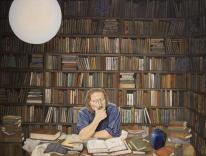One of the greatest stories of friendship and loss (in fact the world’s oldest story, period) has just been translated for children: Gilgamesh the Hero written by Carnegie Medal-winning Geraldine McCaughrean, illustrated by David Parkins (Eerdmans, 95 pp., $18, ages 9 and up). Gilgamesh is a millennium and a half older than the Iliad, and tells the story of the Sumerian King of Uruk (who lived circa 3000 BC in what is now Iraq) as he comes to terms with the hard fact of mortality. It is an affecting, vivid, and multilayered story. At its center is the friendship between a king who drives his people hard to build a city of timber and a savage man named Enkidu who lives with animals until civilized by a city harlot. Archetypally inclined readers see this as the story of culture and nature in tension and in league. Gilgamesh and Enkidu fight each other and then in turn slay the Guardian of the Forest and the Bull of Heaven. These outrages to the gods cannot go unpunished. Enkidu dies and Gilgamesh mourns, with all the intensity and consequence of Achilles, Electra, and other tragic figures. Gilgamesh goes to the edge of the known world to meet a man granted immortality by the gods, seeking the same for himself. That man, Utnapishtim, tells him the story of the flood, which children will be interested to learn morphed over time into the Bible’s Noah story. And he gives Gilgamesh a chance at immortality that Utnapishtim, weakened by his grief and quest, simply cannot achieve.
The story of Gilgamesh was written on stone tablets that were first recovered by British explorers in the Victorian era. McCaughrean does a fine job, crafting the tale so that it is both readable for children (the harlot scenes, for example, are well handled) but not overelaborated and moralized. In an exception, she asserts that killing displaces the fear of death, but given the tale and our times who can blame her? The odd unfamiliar English word like ”footling” pulls one up but does not stop the reader. Parkins’s pictures honor the story’s ancient and raw feeling.
Another successful retelling from England is The Random House Book of Shakespeare Stories, by Andrew Matthews, illustrated by Angela Barrett ($20.95, 117 pp., ages 7 and up). These distillations of eight of Shakespeare’s most famous plays are spare compared with the decade-old classic Shakespeare Stories by Leon Garfield, illustrated by Michael Foreman. For his versions, Garfield, a top juvenile novelist, transformed each play into a novella, brilliantly weaving the many strands of each into a coherent and engaging narrative. Matthews, by contrast, drops or tightens side plots and eliminates some characters, compressing the plays into almost Aesopian revelations (indeed, each ends with a summarizing line drawn from the play itself). The strategy works, especially for younger readers, except in the case of Twelfth Night where the pace is dizzying and the liberties large. (Where is Olivia’s veil? Why no Feste? And wait a minute, Viola never appears in women’s clothes!) The writing is strong and Barrett’s illustrations are fabulous. Her special, but certainly not only, talent is conveying held-back emotion.
Were I to win the lottery (a favorite fantasy, even for the nonplayer), I would buy a copy of Robin Hirsch’s FEG: Ridiculous Poems for Intelligent Children, illustrated by Ha (Little, Brown, $15.95, 48 pp., ages 10 and up) for every fifth-grader in America-and maybe every college freshman, too. Yes, poetry is emotion recollected in tranquility, but it’s also playing in the muck of language. That’s Hirsch’s emphasis. Published last year, the book was born out of Hirsch and his two sons’ everyday fooling around with words “at home, in the car, at the beach, in restaurants.” Alliteration, eye rhymes, spoonerisms, sonnets, and much more are well explained and exemplified. With its clever poems, nimble footnote rifts, and warm introduction, FEG is an intelligent, inviting, and even inspiring book. Hirsch wants readers to write and read poems, to participate without fear in talk about and in literature. Ha (familiar from New Yorker covers) keeps the tone light, and his geometrical illustrations echo the book’s emphasis on poetic structure.
Hirsch’s playful exercises are not likely to move or touch you (that’s not the point). For that there is a very fine new anthology, Overheard on a Salt Marsh: Poets’ Favorite Poems, edited by Carol Ann Duffy (Pan Macmillan, £7.99, 111 pp., ages 9 and up). Duffy asked thirty, mostly British, poets “whose poems are generous to younger readers as well as to older ones” to contribute a poem of their own along with a childhood favorite. The result is a magical grab bag that includes Charles Causley’s hilarious, easily and instantly memorized “Jolly Hunter” (“jolly old safety catch not jolly on”) as well as an aching, sharp memory of bullying, “Back in the Playground Blues,” and the wonderful title poem by Harold Monro. The anthology includes well- and lesser-known work by familiar poets Edward Lear, Walter de la Mare, Elizabeth Bishop, Edna St. Vincent Millay, Hilaire Belloc, Ogden Nash, and Robert Louis Stevenson. But many terrific new poems by unfamiliar poets are what set this volume apart.
Go north, young reader! You too, if you are thinking of buying some books for children this Christmas. Sweden is a mecca for picture books of visual and emotional depth. That’s largely due to husband-and-wife team Olof and Lena Landström, who, from 1992 to 1995, created a perfect picture-book series about a young boy named Will: Will Goes to the Beach, Will’s New Cap, Will Gets a Haircut, and Will Goes to the Post Office (R&S Books, $4.95 paper, ages 2 and up). The Landströms concentrate on everyday adventures and mishaps. What is the secret of their perfection? The archetypal mother, in red dress and pearls in this case, who sets boundaries that are both reassuring and liberating. The visual understatement and concentration. A pace (aided by excellent translations) that allows small, witty revelations. Emotions that are transparent and pure. Will learns to swim, scrapes his knee, gets a wild haircut, and all without a hint of hyperbole, so that the inner life of a child, with all its small victories and hurts, shimmers forth.
The Landströms continue to work full tilt, although not collaboratively. (The couple have a second, wry series about a pair of sheep called Boo and Baa [R&S Books, $9.95, ages 2 and up], which, while lacking Will’s emotional resonance, is great fun). Olof’s latest illustrations are for fellow Swede Peter Cohen’s Boris’s New Glasses (R& S Books, $15, ages 4-9, translated by Joan Sandin). A tattered-looking woodchuck learns from his television repairman that his inability to focus the television is an eye rather than a technical problem. The doctor provides a diagnosis and a remedy. It’s amazing how transforming both can be: “I’m astigmatic and it’s hereditary,” intones Boris. (Here Cohen bows to the late William Steig who knew the pure joy of a big word.) On the strength of those words, and a pair of eyeglasses, Boris gets a job, a sense of what he does and does not want to see, and maybe even a girlfriend. With wit and smarts, Landström underscores that this is a story about vision. My third time through I realized how neighborly and compact a world he has created through alternating close-ups and long shots in his illustrations.
Olof has also teamed up with one of Sweden’s finest and best-known children’s writers, Barbro Lindgren, for Benny and the Binky (R&S Books, $15, ages 4 and up, translated by Elisabeth Kallick Dyssegaard), a follow-up to their comical Benny’s Had Enough. Benny the pig has a new sibling and consequently some new feelings. The master of deadpan, here’s how Lindgren opens the book: “Benny has a brother now. He wanted one. And then he got one.” Landström’s visual understatement (the opening page shows nothing more than a basket) proves a perfect foil for Lindgren’s prose.
These are fun books with fun details of modern Northern European life (potato bins and computers mingle without any strangeness). At the same time, Landström creates a dark sense of public space, one largely uninhabited by a nation of computer users.
Lindgren has also joined forces again with illustrator Eva Eriksson to create Julia Wants a Pet (R&S Books, $15, ages 3 and up, translated by Elisabeth Kallick Dyssegaard). This radiantly full and simple book about wanting a living companion echoes their unsurpassed Andrei’s Search, about which I raved in an earlier column (November 17, 2000). Julia measures the distance between Swedish and American sensibilities. We have our Olivia and our Lilly (she of the purple plastic purse) stomping through picture books with girl (and consumer) power. Julia’s desire is just as fierce, but given poverty and domestic constraint, that desire is driven inward where it becomes poetry. Bugs get collected and properly mourned. A boy becomes a pet. Her apartment buildings “remind her of an Advent calendar, especially in the evening when all the windows are lit up.” Adults have written this landscape off as blighted. Against this Lindgren and Eriksson assert: “Childhood homes are always lovely.” Are they? As in Andrei’s Search, Lindgren shows not only how gorgeous but how unnerving childhood imagination can be, especially when intensified by want.
Not only have the Swedes produced great artistry for children, but they know genius when they see it. This year the government awarded its new and highest prize in international children’s literature-the Astrid Lindgren Award-to Maurice Sendak. He has a stunning new book, Brundibar (Hyperion, $19.95, ages 3 and up) that takes its title from and revives a 1938 Czech opera. Sendak illustrates and dramatist Tony Kushner provides the retelling of the story of two penniless and fatherless children on a quest to get the fresh milk that the doctor says will revive their sick mom.
Sendak has given us the most memorable image of the season (and maybe of his distinguished career) in his illustration of the mother sitting up in bed hugging her children. A crucifix, hitherto hidden by the action, is now centrally displayed. Its coloring draws the eye to the similarly colored star of David on the doctor’s coat, and to his words “Mazel tov,” which he says as he steps joyfully toward the door. Who cured this woman? The brave children. The hundreds of children and adults who fought back against the bullying street performer Brundibar’s attempts to thwart them from singing for their mother’s milk. The inspiring magical animals. The man-god on the cross. The Jewish doctor.
The image clarifies earlier ones where Jews and non-Jews mingle, often reaching out toward one another. The opera, by Adolf Hoffmeister and Hans Krasa, was performed by the children of the Terezin concentration camp fifty-five times between 1942 and 1944. Krasa, the composer, was deported from Terezin to Auschwitz where he was killed in 1944. It’s a great tale of hope. On the book’s final page, the tyrant Brundibar tries to get the last word, and literally overwrite the hopes of the children of Terezin: for now he says, he is defeated but he will return in another incarnation. Meanwhile, the buoyant doctor keeps joyfully high-stepping over Brundibar’s words.
Sendak, an overtly Jewish artist, has long drawn on Christian imagery. Brundibar’s explicit mingling of Jewish and Catholic strikes me as a hopeful turn: maybe it’s Sendak’s tribute to Pope John Paul II’s recognition that the church must repent. It may be his reminder that Jews and Catholics once mingled with each other throughout Europe. The Holocaust, we must pray, is not the only Jewish/Christian story.
Sweden, England, the Czech Republic. They’re Europe, and all north and east of the United States. So what about recent literary productions of our own Northeast? “I see-New Englandly,” wrote Emily Dickinson. There is a consciousness shaped by the region’s history and landscape. Reticence, fortitude, a secret hyperbole in the inner life, tightness with the cash, moral sureness, and a hesitation before pleasure are all markers. They are embodied in Polly Horvath’s new novel, The Canning Season (Farrar, Straus and Giroux, $16, 196 pp., ages 12 and up). Horvath is a strong, funny juvenile novelist, and this is a strikingly philosophical and macabre addition to her oeuvre. The Canning Season follows the fortunes of an adolescent girl named Ratchet who is farmed out one summer from Florida to Maine to live with the “Menuto twins,” her ninety-one-year-old great-second cousins once-removed. Her mother is repelled by Ratchet’s birth defect (a growth on her shoulder) and fearful that it will impede her social climbing and romantic life. Ratchet spends weeks recovering from this rejection, and adjusting to her strange hostesses. Even fellow rural Mainers judge the Menuto twins odd: that’s because they live in a remote mansion without any modern conveniences (ancient car excepted) or desire for companions, and surrounded by voracious bears. Just when the twins and Ratchet begin to come together, another waif, Harper, arrives, also adolescent, also abandoned. She is more modern, cannier, and less fetching than Ratchet on the face of it; but bit by bit these old New Englanders provide the children with a home, one that both choose to make permanent.
This slim book is capacious in style and substance. It includes meditations on the impact of modern communications on human communities and consciousness, eerie vignettes in which the twins describe their youth, including their mother’s suicide by guillotine, antic scenes of dotty old folk trying to help wounded young people, and affecting moments of restrained love. At the end, Horvath generously sets these girls’ lives right, and depicts the passing of the Menuto women with great delicacy. Some warnings to parents: there is that recalled suicide (so hyperbolic that it’s almost not shocking, but kids may feel otherwise), as well as abandonment, and some swearing. If you feel it may be too much, start with Horvath’s hilarious and newly reprinted 1989 An Occasional Cow (FSG Sunburst, $5.95, 132 pages, ages 7-12). It’s about a Manhattan girl who has to spend the summer with her heretofore unknown relatives in Iowa. Safer territory.
New England novelist Allen Kurzweil wrote his first children’s novel on a dare from his nine-year-old son while both (Red Sox fans) were fretting over the curse of the Bambino. The result is Leon and the Spitting Image (HarperChildrens, $15.99, 320 pp., ages 9-12). Leon, still missing his dead father, lives with his mom in a hotel room (she is the night clerk) right next to a loud, malfunctioning ice machine. He doesn’t get enough sleep and is worried that he will not survive fourth grade. Lumpkin, a bully, and stitchery-mad Miss Hagmeyer, his teacher, are particular worries. Hagmeyer teaches everything, including the Middle Ages, by making the children sew. The kids have to sew animales which she never returns, and which they suspect she is selling. When the final project is a sewn figure of the child’s own choice, Leon is inspired to depict his weird teacher: a bit of spit applied as a result of one more assault by Lumpkin makes the doll magical. Leon finds that whatever he does to the doll, Miss Hagmeyer will do before the class. How to use this magic composes the latter half of book. This is a goofy, heartwarming tale. Lots of adults (every one well sketched) are cheering Leon on: especially his mom, folks at the hotel, the Haitian cab driver who takes him to school, and two plumber conventioneers who fix that darn ice machine. Two solid friends, one being a girl and one a boy, have different ideas of how to handle the doll’s power. There are surprises for everyone when Hagmeyer turns out to be more benevolent (and dedicated to the medieval virtue of caritas) than she appears. And charity, as you know gentle reader, does not depend on personality. end
Please email comments to [email protected] and join the conversation on our Facebook page.
Previous Story
Sylvia
Next Story
Pastor Eveline


